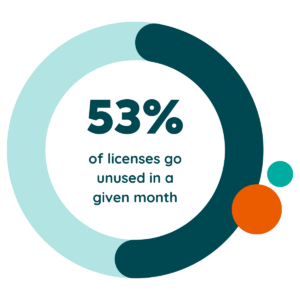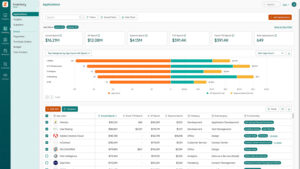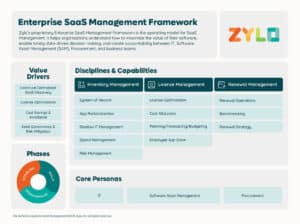Table of Contents
SaaS is now the second-largest operating expense in many organizations—but most teams still manage it in silos. Tools are purchased without oversight, renewed without usage data, and tracked in spreadsheets that offer no unified view. The result is sprawl, waste, and risk, because the collaboration required to manage SaaS efficiently hasn’t been defined.
According to Zylo’s 2025 SaaS Management Index, the average enterprise spends $49M annually on SaaS—and uses just 47.3% of licenses each month. That’s more than inefficiency. It’s a direct hit to budgets, compliance posture, and strategic agility.

To turn the tide, organizations must align IT, Procurement, Software Asset Management (SAM), and FinOps around shared goals. SaaS Management collaboration is no longer optional—it’s the key to managing cost, risk, and complexity at scale.
 “When you come together and operate as one, there’s much more power in that,” explained Gordon Atkin, VP of Technology and Business Platform at Salisfy, on SaaSMe Unfiltered podcast.
“When you come together and operate as one, there’s much more power in that,” explained Gordon Atkin, VP of Technology and Business Platform at Salisfy, on SaaSMe Unfiltered podcast.
This guide breaks down what that collaboration actually looks like:
- How IT and Finance teams collaborate for SaaS efficiency
- What each function brings to the table
- How to eliminate waste, avoid surprise renewals, and enforce governance without slowing the business down
- And how leading organizations are achieving real results through cross-functional SaaS Management
SaaS Management doesn’t fail because of a lack of tools—it fails because teams aren’t working from the same playbook. If you have growing SaaS costs and no clear ownership, this is your starting point.
Why SaaS Management Requires Cross-Functional Collaboration
SaaS sprawl is accelerating. And without intentional, cross-functional collaboration, it becomes impossible to manage. Legacy assumptions about ownership no longer apply.
Today, IT owns just 26.1% of SaaS spend and only 15.9% of applications, while business units account for 70% of spend and over half of all app ownership. That means most of your SaaS ecosystem is managed outside of IT—and often outside of any formal process.

This decentralization creates risk: contracts are signed in silos and apps are expensed without oversight. Renewals execute without input from SAM, IT, or application owners, and financial waste is baked into the system.
That’s why we like to say that SaaS Management is a team sport. Each team holds part of the solution:
- IT needs visibility and access controls across the portfolio
- SAM needs usage data and license entitlements to reduce audit risk
- Procurement needs centralized renewal visibility and vendor insights
- FinOps needs reliable spend data to forecast and optimize SaaS costs
But they can’t succeed independently. Strategies for effective SaaS Management collaboration require shared KPIs, unified systems, and clear roles. When teams align around SaaS governance, license utilization, and renewal readiness, they stop reacting and start driving strategic outcomes.
The Role of IT in SaaS Management Collaboration
IT remains responsible for securing, governing, and maintaining performance across enterprise software. But today, most SaaS tools are purchased without their input. That disconnect creates serious risk—from potential noncompliance and security gaps to unauthorized user access. Without full visibility, IT is left reacting to issues they didn’t cause, supporting tools they didn’t approve, and plugging gaps in systems they never implemented.
The scope of IT’s responsibilities hasn’t narrowed. It has grown. Teams must manage SSO integrations and user access, ensure secure offboarding, monitor usage patterns, and support system performance across increasingly fragmented environments. Yet IT only owns about 15.9% of SaaS applications in the average organization. Their influence is limited, and new apps often enter the stack without notice.
To make SaaS Management collaboration work, IT must shift from gatekeeper to enabler. This means building systems that enable distributed ownership while maintaining control through smart guardrails and shared data.
Here is what effective collaboration looks like from the IT perspective.
1. Visibility Without Ownership
IT doesn’t need to approve every tool, but it does need to see the full picture. A SaaS system of record provides that clarity. It allows IT to monitor inventory across business units, flag potential risks, and proactively plan for performance and compliance.
2. Automated Access and Offboarding
Manual user provisioning wastes time and creates a security risk. With most SaaS purchased outside of IT, automated onboarding and offboarding through SSO and lifecycle workflows become essential. These workflows help reduce friction and support secure access for high-turnover roles.
3. Shadow IT Identification
Unauthorized tools often enter through expense reports or employee purchases. According to Zylo’s 2025 data, employee-led software purchasing accounts for 33.6% of applications and nearly 4% of total SaaS spend. IT teams need visibility into these purchases to recommend approved alternatives and mitigate risk.
4. Risk Mitigation and Governance
IT is ultimately responsible for protecting company data. Even if another department purchases a SaaS tool, compliance reviews, security protocols, and user policies must be applied consistently. That requires collaboration with SAM, Procurement, and Finance to enforce effective SaaS governance without slowing down business needs.
Where IT Fits in the Collaboration Framework
- Primary focus: Visibility, access control, risk mitigation
- Dependencies: Usage data from SAM, renewal timelines from Procurement, cost modeling from FinOps
- Collaborative goal: Enforce SaaS governance policies and streamline access, without becoming a blocker to productivity
The Role of Procurement in SaaS Management Collaboration
Procurement is central to controlling SaaS growth and spend. As software buying shifts toward departments and individual users, Procurement is expected to maintain discipline and reduce risk. But without access to real-time data, that job becomes reactive rather than strategic.
The speed of SaaS purchasing often exceeds the pace of traditional procurement workflows. Contracts are signed in days. Renewals happen automatically. Teams add tools for tactical needs, bypassing vendor standards and skipping negotiations altogether. According to recent data, only 22.8% of SaaS contracts are multi-year, representing a 22.6 percent decrease year over year. This trend gives organizations flexibility but introduces renewal chaos and exposes them to rising costs without sufficient oversight.

Adding to the complexity, contract terms are evolving. AI features now come with premium pricing, and consumption-based models fluctuate from month to month. Without visibility into license usage or peer benchmarks, procurement teams often negotiate in the dark.
Enabling Procurement Through Collaboration
Procurement can only manage what it can see. A collaborative SaaS Management approach provides this team with the tools and data necessary to act strategically. To manage SaaS renewals and purchasing effectively, Procurement needs:
- A centralized system of record with contracts, renewal dates, and owner visibility
- Advance alerts for renewals, ideally 90 to 120 days ahead
- Usage data and license tier breakdowns to evaluate whether current terms fit actual needs
- Insight into app overlap across departments to identify opportunities for consolidation
With these inputs, Procurement can take control of the process. They can prevent auto-renewals, reduce unplanned purchases, consolidate vendors, and negotiate pricing based on how software is actually used.
“Now we have renewals tracked and a centralized view of contracts. That helps Procurement step in with the information they need, instead of finding out something renewed after the fact.”
— Tara Kalkwarf-McGee, Vendor Management Office Manager, SADA
Where Procurement Fits in the Collaboration Framework
Primary focus: Renewal management, vendor optimization, spend control
Dependencies: Usage insights from IT and SAM, contract data from across the business
Collaborative goal: Align SaaS purchasing with value and performance, while reducing unplanned or unmanaged spend
The Role of Software Asset Management (SAM) in SaaS Management Collaboration

Software Asset Management (SAM) was built for on-premises software, tracking license entitlements, ensuring audit readiness, and optimizing usage across long-term vendor agreements. However, in today’s SaaS-driven environment, SAM professionals are being drawn into a new reality: high volumes of applications, rapidly changing license models, decentralized ownership, and a lack of a clear system of record.
Many SAM teams are still expected to manage software assets, but without visibility into SaaS usage, renewals, or spend. That gap increases the risk of noncompliance, wasted licenses, and audit exposure. The average license utilization rate is 47.3%, meaning that more than half of all purchased licenses remain unused every month. For SAM leaders, this represents a massive and measurable opportunity.
Why SAM Belongs at the SaaS Table
Modern SAM professionals bring critical value to SaaS Management—but only when they have access to data and a seat at the table in cross-functional collaboration.
Here’s what SAM brings to the table:
- License rightsizing based on actual usage data
- Audit defense readiness for SaaS vendors
- Chargeback accuracy across business units
- Rationalization oversight to reduce redundancy
What SAM Needs to Be Effective
To fulfill their role in SaaS, SAM teams need:
- Comprehensive SaaS usage data from all sources
- Visibility into license types, tiers, and entitlements
- Renewal timelines and contract terms to align license decisions with budget cycles
- Collaboration with IT and Procurement to integrate license strategy into broader workflows
Too often, SAM teams are left managing a subset of the software estate—at least, the part they can see. But that leaves the largest and fastest-growing segment, SaaS, under-optimized and under-governed.
Where SAM Fits in the Collaboration Framework
- Primary focus: License optimization, compliance, audit defense
- Dependencies: Usage data from IT, contract visibility from Procurement, and spend reporting from FinOps
- Collaborative goal: Eliminate license waste, reduce risk, and ensure the organization stays compliant and cost-effective
The Role of FinOps in SaaS Management Collaboration
FinOps was created to bring control to cloud infrastructure spending. Now, it is expanding its reach to SaaS. As software buying becomes more decentralized and usage patterns more variable, FinOps teams are stepping in to bring structure, accountability, and measurable results to SaaS Management.
The mission is clear: convert technology consumption into business-aligned spend.
SaaS creates many of the same challenges that FinOps has tackled in the cloud. Ownership is fragmented, pricing models are dynamic, and usage is difficult to track across hundreds of apps. The FinOps Foundation now recognizes SaaS as a critical part of the FinOps practice. Managing this category requires the same focus on real-time data, unit economics, and financial governance.
What FinOps Brings to SaaS Management
FinOps professionals are well-equipped to lead SaaS spend optimization. They have experience managing fluctuating spend across platforms and departments, and they apply a disciplined approach that delivers clarity and control.
In the SaaS context, FinOps brings:
- Centralized visibility into fragmented spend from accounts payable, expense data, and department-led purchases
- Metrics that track unit economics, such as cost per license, per team, or per employee
- A collaborative process that grounds renewal and consolidation decisions in actual usage data
FinOps cannot function in isolation. Their work depends on input from other teams:
- IT and SAM provide usage data and license context
- Procurement shares renewal timelines and contract terms
- Finance outlines budget targets and business goals
 Through this collaboration, FinOps can forecast spending, surface overspending before it occurs, and establish stronger cost-to-value alignment across the organization.
Through this collaboration, FinOps can forecast spending, surface overspending before it occurs, and establish stronger cost-to-value alignment across the organization.
This work is becoming more urgent, as 66.5% of IT leaders reported surprise charges from SaaS tools, often due to AI features or usage-based billing models. FinOps is uniquely positioned to prevent those surprises and help organizations stay ahead of unpredictable spend.
Where FinOps Fits in the Collaboration Framework
Primary focus: SaaS spend forecasting, unit economics, cost modeling
Dependencies: Real-time usage data from IT and SAM, renewal planning from Procurement
Collaborative goal: Optimize SaaS spend, reduce variability, and ensure every software investment aligns with business value
FinOps already plays a key role in cloud cost management. Extending that discipline to SaaS is a logical and necessary next step for organizations seeking greater visibility and control across their technology portfolio.
Breaking Down the Barriers to Effective Collaboration
Everyone agrees that SaaS needs to be managed. But aligning IT, Procurement, SAM, and FinOps is easier said than done. Each team has its own priorities, tools, and language. Without clear connection points, SaaS Management becomes reactive, fragmented, and inefficient.
The barriers are rarely technical, and are more often structural.
- Unclear ownership: Who makes the call on renewals, license reductions, or vendor rationalization?
- Fragmented data: Teams operate without a shared view of usage, spend, or entitlements.
- Conflicting goals: IT prioritizes governance. Procurement focuses on control. FinOps demands predictability. Business units want speed and flexibility. Yet, each should align to your organization’s strategic objectives.
- Poor communication: Poor misalignment erodes trust, creates friction in processes, and reduces productivity.
These disconnects result in duplicate purchases, missed renewals, unmanaged tools, and stalled cost-saving initiatives. The technology to manage SaaS already exists. What’s missing is a collaboration model that connects every function.
Tactical Fixes to Build a Collaborative SaaS Management Strategy
Cross-functional SaaS Management collaboration doesn’t happen by chance. It must be built into workflows and systems from the outset. These four strategies are crucial for aligning teams and ensuring they act in sync.
1. Centralize SaaS Data in a System of Record
Teams cannot collaborate if they are working from different spreadsheets or partial platforms. A SaaS system of record consolidates spend, usage, ownership, contract terms, and renewal dates in one centralized location. This unified view supports transparency and enables smarter decisions.

2. Establish a SaaS Center of Excellence (CoE)
Form a cross-functional team with stakeholders from IT, SAM, Procurement, and FinOps. This group defines governance standards, approves tool categories, prioritizes renewals, and drives accountability across departments. A CoE ensures SaaS governance stays consistent and aligned with business goals.
3. Create a Shared Renewal Calendar
Renewals should never catch anyone off guard. Set automated alerts to flag contracts 90 to 120 days before expiration. With time to evaluate usage, costs, and ownership, teams can approach renewals proactively and collaboratively.

4. Define and Align on Shared KPIs
SaaS Management collaboration works best when teams share accountability for outcomes. Key performance indicators should reflect goals that span across departments, such as:
- License utilization rate
- Cost per active user
- Percentage of applications behind SSO
- Reduction in redundant tools
- Renewals completed with usage-based decisions
Organizations using collaborative governance structures report faster insights and stronger renewal outcomes. They reduce internal conflict, cut waste, and unlock more value from every application.
When collaboration is designed into the process, SaaS Management becomes strategic rather than reactive. Teams spend smarter, eliminate redundancy, and move faster, because they are finally working from the same playbook.
The Framework for Operationalizing SaaS Management Collaboration
SaaS Management collaboration works best when it’s backed by a structured approach. Once IT, Procurement, SAM, and FinOps are aligned on goals, the next step is execution. The Enterprise SaaS Management Framework provides a model to help organizations scale collaboration with defined roles, repeatable workflows, and shared accountability.
The framework centers around three core disciplines: inventory management, license management, and renewal management.

Inventory Management
The goal of inventory management is to create a complete and accurate view of all SaaS applications used throughout the organization. This includes software purchased through Procurement as well as tools acquired directly by teams or individuals.
Visibility starts with discovery. SSO integrations, accounts payable feeds, and expense reports help identify both sanctioned and unsanctioned tools. Once identified, applications must be assigned owners, mapped to business functions, and categorized to spot redundancies and drive standardization.
Team Roles:
- IT: Leads application discovery and manages SSO integrations
- Procurement: Flags vendor overlap and non-compliant purchases
- SAM: Confirms license claims against actual app inventory
- FinOps: Reconciles spend data with departmental budget ownership
License Management
This pillar focuses on aligning software entitlements with actual usage. The goal is to reduce waste, eliminate shelfware, and improve adoption. License management helps turn ownership into a value-driven process rather than a static record.
Activities include monitoring utilization, identifying unused seats, downgrading license tiers, reclaiming inactive accounts, and producing accurate chargeback reports to inform financial planning.
Team Roles:
- SAM: Owns license rightsizing and performs detailed usage analysis
- IT: Manages access workflows for onboarding and offboarding
- FinOps: Assesses the budgetary impact of license decisions
- Procurement: Uses utilization insights to strengthen renewal strategy
Renewal Management
Renewals are where strategy and timing come together. Rather than reacting to vendor outreach or missed deadlines, effective teams operate from a shared renewal calendar that includes usage trends, ownership visibility, and contract terms.
This proactive approach allows teams to evaluate vendor performance, plan internal recommendations, and identify opportunities for vendor consolidation or better contract terms.
Team Roles:
- Procurement: Leads vendor negotiations and strategy
- SAM: Validates usage data and license requirements
- IT: Flags performance risks and compliance issues
- FinOps: Measures renewal impact against spend forecasts and targets
Aligning the Framework to Stakeholders
The Enterprise SaaS Management Framework simplifies complexity by assigning ownership where it belongs. At the same time, it ensures every stakeholder has the shared data and workflows needed to act with speed and confidence. That’s how cross-functional SaaS Management collaboration becomes scalable, repeatable, and accountable across the enterprise.
What Success Looks Like: 3 Outcomes of Real SaaS Management Collaboration
When SaaS Management becomes a cross-functional effort, the results speak for themselves. Costs are reduced, renewals become more strategic, and decisions are made faster and with better data. Risk declines while operational efficiency improves.
SaaS Management collaboration between IT, SAM, Procurement, and FinOps drives improvements across three key areas: spend optimization, renewal performance, and SaaS sprawl control.
1. Reduced Waste, Increased Efficiency
Over-purchasing remains one of the most frequent causes of wasted SaaS spend. Many teams overbuy licenses to avoid running short, bypass administrative steps, or stay compliant with unclear vendor guidelines. Without accurate usage data, the safest path often means over-provisioning, which leads to unused licenses and a lost budget.
Collaborative license management directly addresses this issue:
- SAM identifies underutilized licenses across the application stack
- IT reclaims and reassigns seats using automated workflows
- Procurement adjusts contract volumes based on real needs
- FinOps measures the impact on spend and ties the budget to adoption
For example, ModMed’s IT and Procurement teams partnered to drive $3M+ in cost savings and avoidance. IT used Zylo to monitor license utilization and automate reclamation workflows. Once unused licenses were deprovisioned, they handed Procurement a more realistic license quantity for the business’s need. Then, Procurement used that information to negotiate price reductions at renewal.
ModMed Drives Operational Excellence & Million-Dollar Savings with Zylo SaaS License Management
Discover how ModMed used Zylo’s powerful license tracking and optimization to save millions of dollars, drive operational excellence, and improve the employee experience.
2. More Negotiation Power at Renewal
Collaborative renewals give organizations leverage. When teams align early, they avoid reactive decisions and take control of vendor relationships. Shared visibility into usage trends and contract terms enables everyone to negotiate more effectively.
- Procurement benchmarks pricing and negotiates with vendor-specific insight
- SAM verifies license requirements and app usage before contracts are signed
- FinOps forecasts the financial impact of the renewal, including cost-per-user trends
Zylo customers who use benchmarking and negotiation services reduce total SaaS spend by up to 15%. For example, SADA realized $50K in cost avoidance within the first week of onboarding Zylo, using the Benchmarks tool.
3. Control Over SaaS Sprawl
SaaS portfolios expand quickly. According to the 2025 SaaS Management Index, the average organization experienced 33% year-over-year growth in the number of SaaS applications. Unchecked, this growth creates redundancy, inconsistent user experiences, and higher compliance risk.
With collaborative inventory management:
- IT and SAM identify duplicate tools and underused applications
- Procurement consolidates vendors and improves contract efficiency
- FinOps aligns the budget with strategic needs to prevent unplanned spending
Zylo customers have kept portfolio growth significantly lower than the market average by putting structured governance and role-based ownership in place. For instance, when Adobe first implemented Zylo, they discovered 2,600+ applications. After rationalization, the SAM and IT teams established 400 standard software titles and implemented governance to stop unsanctioned purchasing.
Adobe Drives Innovation and Massive Savings with Zylo
In the past 4 years, Adobe has rapidly scaled from $9B to $18B. This growth has made an already complex environment even more complex. Learn how they leveraged Zylo to get complete visibility into their SaaS portfolio, unlock millions in cost savings and avoidance and improve the employee experience.
Next Steps: Building a Culture of SaaS Collaboration
Effective SaaS Management depends on structure, visibility, and aligned execution. When IT, SAM, Procurement, and FinOps operate from a shared foundation, decisions become faster, more strategic, and more cost-effective.
To build a durable, collaborative approach to SaaS Management, follow these key steps.
1. Define Roles and Responsibilities
Clear accountability prevents confusion and keeps workstreams on track. Build a RACI matrix that identifies who is responsible, accountable, consulted, and informed for each key function:
- SaaS discovery and inventory tracking
- License optimization and reclamation
- Renewal negotiation and contract evaluation
- Governance enforcement and tooling standardization
Assign an executive sponsor to ensure sustained alignment and cross-functional accountability.
2. Centralize Your Data
When data lives in silos, collaboration breaks down. Use a SaaS system of record to bring together all critical data in one place, including:
- Usage and spend trends
- License entitlements and contract metadata
- Application ownership and compliance requirements
With unified access, teams stay informed and empowered to take action based on shared insights.
3. Align on Business Outcomes
SaaS Management collaboration should tie directly to business value and focus on measurable goals. Tracked your goals over time and integrate KPIs into quarterly planning or performance reviews.
Typically, SaaS Management supports business outcomes such as:
4. Build a SaaS Center of Excellence (CoE)
A formal governance group gives structure to your collaboration model. The SaaS CoE should include representatives from IT, SAM, Procurement, and FinOps and have the authority to:
- Evaluate tooling and renewal requests
- Track KPIs and guide optimization efforts
- Update policies and processes as business needs evolve
As your SaaS portfolio grows, the CoE ensures that governance and efficiency scale along with it.
Zylo Supports SaaS Management Collaboration at Scale
Zylo is the leading SaaS Management platform built to empower cross-functional SaaS collaboration. By providing a unified foundation for IT, SAM, Procurement, and FinOps, Zylo enables smarter decision-making and faster execution across the software lifecycle.
Here’s how Zylo makes that collaboration actionable:
- Creates a shared source of truth: Real-time usage, spend, and contract data accessible to all teams
- Coordinates automated workflows: License reclamation, renewals, and offboarding handled consistently
- Delivers role-based insights: Dashboards tailored to each team’s priorities
- Supports unified vendor strategy: Shared data enables smarter negotiations and alignment
- Reinforces governance and standards: Visibility and accountability built into every process
👉 Download the No-BS SaaS Management Playbook to take the next step toward SaaS collaboration at scale.
The No-BS SaaS Management Playbook
Learn MoreFAQs About SaaS Management Collaboration
Who owns SaaS Management—IT, Procurement, SAM, or FinOps?
SaaS Management is not owned by a single function. It’s a shared responsibility that spans multiple teams, each accountable for a critical part of the SaaS lifecycle.
- IT: Owns application strategy, access control, governance, security, and integration.
- Procurement: Owns contracts, vendor relationships, renewals, and negotiation strategy.
- SAM: Manages license entitlements, optimization, and audit defense.
- FinOps: Monitors spend, enables forecasting, and drives unit economics across business units.
Ownership should be distributed but coordinated, with shared visibility and aligned KPIs across all functions.
How should renewals be handled to avoid surprises and overspend?
Renewals should be planned, not reactive. Maintain a centralized renewal calendar with contract metadata, usage data, owner visibility, and automated alerts 90–120 days in advance.
Before renewal:
- Procurement benchmarks pricing and evaluates consolidation opportunities.
- SAM validates license needs and usage.
- FinOps provides cost modeling and budget input.
- IT flags compliance or performance issues.
How can we reduce redundant apps across departments?
Begin by creating a comprehensive inventory of SaaS applications. Use discovery methods such as SSO, expense reports, AP integrations, and direct API connections to uncover all applications—approved or not. Then, identify redundant apps and assess usage and business needs with app owners. Use that data to consolidate vendors, eliminate shelfware, and standardize tooling.
How do we enforce governance without slowing down the business?
Governance requires clear policies and automation—not bottlenecks. Define app approval workflows involving IT, SAM, and Procurement. Publish a pre-vetted app catalog to guide employees to approved tools. And automate onboarding and offboarding to ensure proper user access. This enables business units to move fast while maintaining compliance and control.
Do we need a SaaS Management platform to make collaboration work?
Yes. A SaaS Management platform is the system of record that enables operational collaboration. It centralizes the data and workflows required for shared decision-making. Zylo connects IT, SAM, Procurement, and FinOps through a single platform—ensuring every team has access to the same insights, automation, and performance metrics.


 —
—